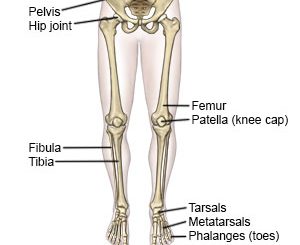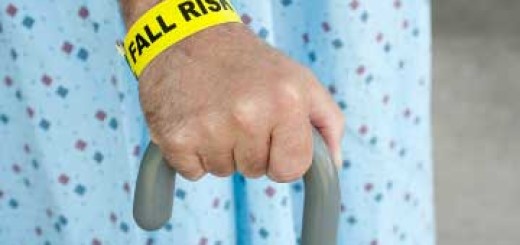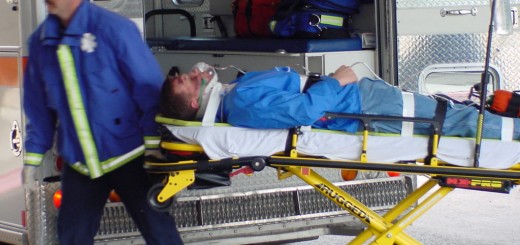First Aid for Bruises: 4 Effective Relief Tips
Bruises are quite commonly seen among children and usually occur due to minor accidental injuries. However, did you know that bruises can also often signal underlying medical illnesses or maltreatment?
Regardless of how someone gets a bruise, I do believe it’s important for us to know how to treat them, whether for ourselves or the ones around us.
The medical term for a bruise is ecchymosis. A bruise or contusion appears on a person’s skin as a result of trauma, which could occur due to blows or cuts on a given area of one’s body.
When a person gets injured in this way, it causes the capillaries (which are tiny blood vessels) to burst. Due to this, blood gets trapped underneath the surface of the skin, leading to a bruise.
Even though bruises cause blood to pool beneath the skin, there is no external bleeding that takes place unless the person’s skin breaks open. It’s the collection of blood that causes a bruise to be visible. In order to help you heal from the bruise, the blood cells in the body repair the damaged blood vessels.
An individual can get bruised at any age. Certain bruises are smaller in size and are not too painful. Although bruises can be common, being aware of the treatment options is vital, which includes knowing whether your situation requires emergency medical attention.
If you want to know how bruises can be treated, then that’s what we are here for. In this article, we will discuss first aid for bruises, the symptoms and causes, and how they can be prevented.
What are the Symptoms of Bruises?
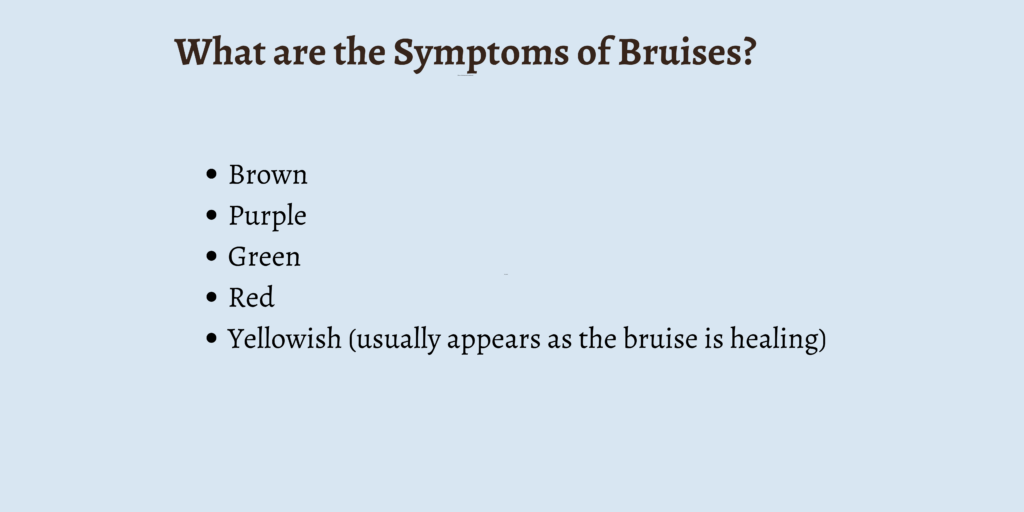
The cause of a bruise usually determines the symptoms you could experience. The skin getting discolored is often the first sign of a bruise. Although black and blue are the usual colors of a bruise, they can also be:
- Brown
- Purple
- Green
- Red
- Yellowish (usually appears as the bruise is healing)
Pain and tenderness in the injured area can be common with bruises. These signs go away as the bruise keeps healing.
There are certain symptoms that point to more serious conditions. Get immediate medical attention if you experience these circumstances:
- Bruise getting amplified when you take aspirin or other blood thinners.
- Bruise that takes place with a suspected broken bone.
- Pain and swelling where the bruise is present.
- Painful bruising under your nails.
- Having a bruise after a hard fall or blow.
- Bruise that doesn’t go away even after four weeks.
- Bruise that is accompanied by blood in the eyes, stool, or urine
What Causes Bruises?
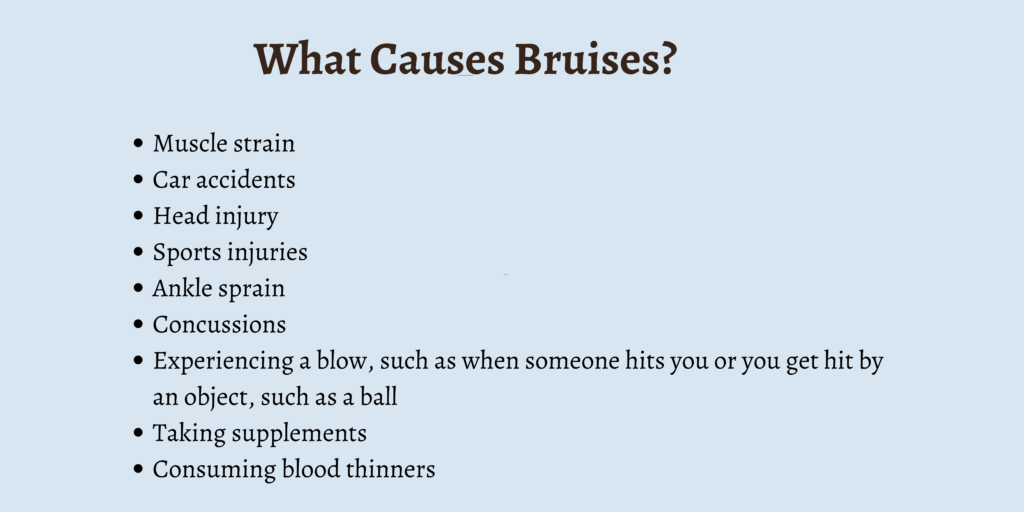
If you see a bruise suddenly appear on your knee or shin, chances are it occurred as a result of bumping into a chair, bedframe, or doorframe without noticing.
Some of the other causes that often lead to bruises are:
- Muscle strain
- Car accidents
- Head injury
- Sports injuries
- Ankle sprain
- Concussions
- Experiencing a blow, such as when someone hits you or you get hit by an object, such as a ball
- Taking supplements
- Consuming blood thinners
If you ever come across a child who has unexplained bruising, take them to a healthcare provider right away to determine what caused it. This is because the bruising could be a result of not only a serious illness, but also abuse.
First Aid for Bruises
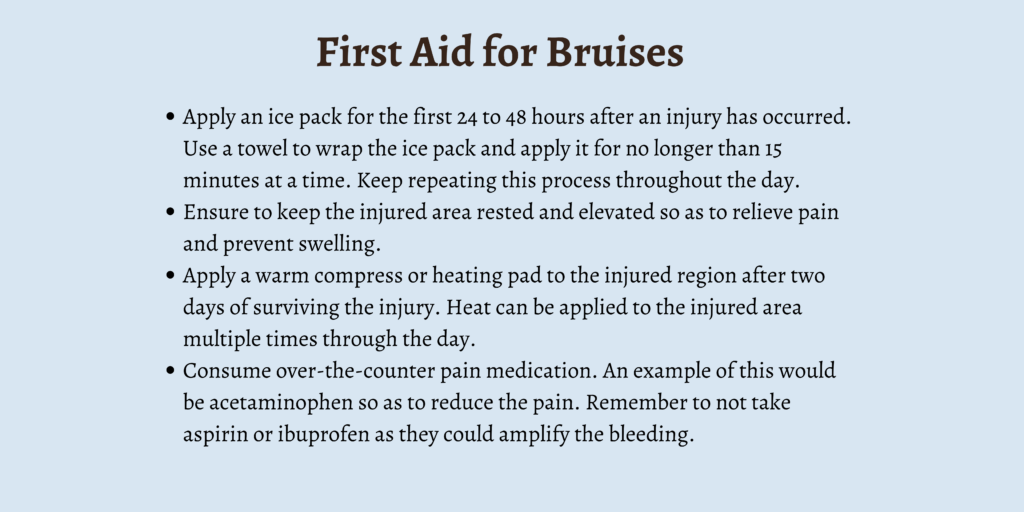
Minor bruises usually fade away without needing any treatment. The severe ones might need to be treated. It is possible to heal a bruise quicker by following these steps of first aid:
- Apply an ice pack for the first 24 to 48 hours after an injury has occurred. Use a towel to wrap the ice pack and apply it for no longer than 15 minutes at a time. Keep repeating this process throughout the day.
- Ensure to keep the injured area rested and elevated so as to relieve pain and prevent swelling.
- Apply a warm compress or heating pad to the injured region after two days of surviving the injury. Heat can be applied to the injured area multiple times through the day.
- Consume over-the-counter pain medication. An example of this would be acetaminophen so as to reduce the pain. Remember to not take aspirin or ibuprofen as they could amplify the bleeding.
How to Prevent Bruises?
While it’s not always possible to save yourself from getting bruised, there are certain precautions you can take to prevent bruises from occurring. These prevention measures include:
- Keeping the rooms and floors clear in a way such that there aren’t any tripping hazards involved.
- Keeping a flashlight turned on every time you walk through poorly or dimly lit areas.
- Wearing the necessary protective gear while riding a motorcycle or bicycle or while playing contact sports.
- Keeping the furniture away from walkways and doorways so that you don’t bump into hard surfaces.
- Consuming enough vitamins through your meals and diet.
FAQs
What are the common signs of bruises?
The common signs of bruises include swelling, discoloration of the skin, and stiffness in the affected joint or tightness in the affected muscle.
What are the stages of bruises?
A bruise is usually red immediately after an injury has taken place. It turns black and blur or purplish within a day or two of the injury. The color could transform into yellow or green in about five to 10 days. Once it has been two weeks or 10 days since the injury, the color of the bruise can appear light brown or yellowish brown.
How long do bruises last?
Bruises usually fade away in about two weeks.
Is it okay to touch a bruise?
No, it’s not at all advised to touch a bruise as it could worsen the injured area. You could also end up breaking more blood vessels under the skin, thereby making the bruise bigger.
Can a bruise leave a scar?
A bruise can cause subsequent scars if there are broken bones near it or if the skin is lacerated.
Does ice stop bruising?
Applying an ice pack within the first 48 hours after an injury has taken place can help in limiting the bruising, relieving the inflammation, and numbing the pain.
Conclusion
Bruises happen to almost everyone at some point or another. If you have a bruise that cannot be explained or you happen to bruise too easily, make sure to see your healthcare provider regarding this matter.
Do get in touch with your doctor under the following conditions:
- If there is blood in your stool or urine.
- If you bruise for no reason at all.
- If you see a lump over your bruise.
- If you’re experiencing pain even after three days of suffering the injury despite the injury seeming minor in the beginning.
By fixing an appointment with your doctor, they can find out if you have an underlying condition that may require treatment. Most of the bruises heal on their own in a couple of weeks, and you can minimize the bruising by applying an ice pack over the injured area right after the injury occurs.

